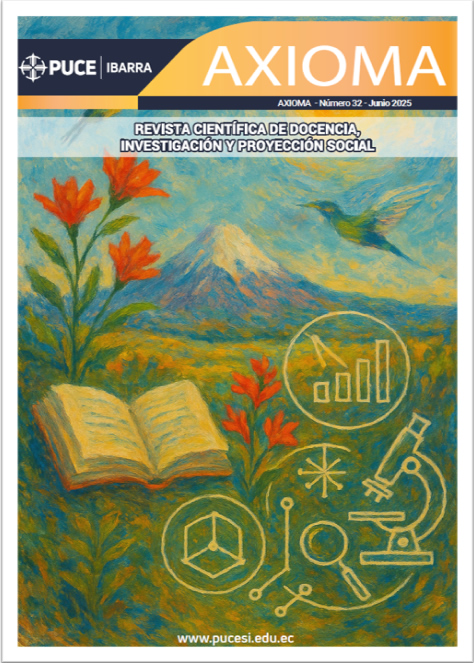La Investigación Arquitectónica Dentro de la Enseñanza del Análisis de Sitio en Arquitectura: Caso de Estudio
Contenido principal del artículo
Resumen
Numerosos estudios han evidenciado que la incorporación de un enfoque investigativo en la enseñanza del taller de arquitectura produce un impacto significativo en el desarrollo integral de los estudiantes. En este contexto, se llevó a cabo un estudio de caso con el objetivo de explorar la percepción de los estudiantes respecto a la implementación de la investigación arquitectónica en el curso de Diseño Arquitectónico Territorial IV, correspondiente al cuarto semestre del periodo académico 2023-01 en la Pontificia Universidad Católica del Ecuador, sede Ibarra. La metodología del estudio incluyó una revisión bibliográfica exhaustiva sobre los procesos y antecedentes de investigación en el ámbito académico de la arquitectura. Asimismo, se aplicó el método de observación participante, que permitió al investigador registrar datos e impresiones de manera naturalista, sin que los alumnos fueran conscientes de su observación. Adicionalmente, se realizaron entrevistas no estructuradas con el coordinador de la asignatura, con el propósito de discutir y analizar las falencias y los resultados obtenidos en el estudio de caso. Los hallazgos del estudio revelan un desarrollo notable de habilidades blandas, tales como el trabajo en equipo y la comunicación asertiva, así como habilidades duras, que incluyen el manejo de herramientas para la recolección de datos, el pensamiento crítico, y la capacidad de análisis e interpretación de información. Estos resultados sugieren que la aplicación de la investigación en el taller de arquitectura ha proporcionado a los estudiantes herramientas y competencias que les han permitido participar activamente en su proceso de aprendizaje. No obstante, se identificó una dificultad en la capacidad de los estudiantes para traducir la información recopilada a un lenguaje arquitectónico apropiado.
Descargas
Detalles del artículo

Esta obra está bajo licencia internacional Creative Commons Reconocimiento-NoComercial-CompartirIgual 4.0.
Con la finalidad de contar con un tipo de licencia más abierta en el espectro que ofrece Creative Commons, a partir de diciembre de 2022 desde el número 27, AXIOMA asume la Licencia Creative Commons 4.0 de Reconocimiento-NoComercial-CompartirIgual 4.0(CC BY-NC-SA 4.0). Tanto el sitio web como los artículos en sus diferentes formatos, reflejan esta información.
![]()
Hasta el mes de noviembre de 2022 con el número 26, la revista AXIOMA asumió una Licencia Creative Commons Atribución-NoComercial-SinDerivadas 4.0 Internacional (CC BY-NC-ND 4.0). Los artículos contenidos en cada número hasta el 26, cuentan con esta licencia y su descripción se conserva en el portal de nuestra revista.
Atribución-NoComercial-SinDerivadas
CC BY-NC-ND
AXIOMA- Revista Científica de Investigación, Docencia y Proyección Social
Citas
Alexander, C. (1964). Notes on the Synthesis of Form. Harvard University Press.
Avila, B., & Gómez Rosales, M. (2011). Proceso de Diseño Urbano-Arquitectónico Arquitectonic-Urban Design Process. In Provincia No (Vol. 25).
Bain, K. (2004). Lo que hacen los mejores profesores de universidad . Universitat de València.
Baper, S. Y., & Ismael, Z. K. (2024). The Impact of Site Contexts in Increasing the Diversity of Architectural Concepts: Using an Interactive Architectural Approach. Buildings, 14(8), 2567. https://doi.org/10.3390/buildings14082567
Du, H.-M., & Yu, W.-D. (2012). The Study of Graphic Design Encoding Based on Knowledge Coupling. Procedia - Social and Behavioral Sciences, 51, 480–488. https://doi.org/10.1016/j.sbspro.2012.08.193
Gatell, A. (2019). Significado del proceso de diseño en la formación del arquitecto. Particularidades en Cuba. Revista de La Facultad de Arquitectura de La Universidad Autónoma de Nuevo León, XIII(19), 72–88. https://www.redalyc.org/articulo.oa?
Izquierdo, H., Rodríguez, I., Ponsot, E., & Briceño, M. (2024). Libro de resúmenes: VI Congreso de Investigación e Innovación y VI Congreso de Lectura y Escritura en la Sociedad Global. 58–60. www.pucesi.edu.ec
Makstutis, G. (2018). Procesos del diseño en arquitectura. Promopress.
Martínez Osorio, P. (2013). El proyecto arquitectónico como un problema de investigación. Revista de Arquitectura, 15, 54–61. https://doi.org/10.14718/ RevArq.2013.15.1.6
Martínez Zárate, R. (1991). Diseño Arquitectónico Enfoque Metodológico. Editorial Trillas. Distrito Federal, México.174 p.
Martínez-Vitor, C. F. (2021). La investigación proyectual como estrategia didáctica en el proyecto del Taller de Diseño Arquitectónico. Revista de Arquitectura, 23(2), 58–70. https://doi.org/10.14718/revarq.2021.3294
Moisset, I. (2013). Enseñar-investigar arquitectura. Limaq, 49–65. https://doi.org/10.26439/limaq2015.n001.352
Morales-Holguín, A., & Gonzalez-Bello, E. O. (2020). Teaching and use of design method in mexico. professors’ perceptions. Formacion Universitaria, 13(1), 35–42. https://doi.org/10.4067/S0718-50062020000100035
Pallasmaa, J. (2020). Animales Arquitectos (1a.). Gustavo Gili.
Park, E. J., Lee, K., & Kang, E. (2023). The impact of research and representation of site analysis for creative design approach in architectural design studio. Thinking Skills and Creativity, 48, 101271. https://doi.org/10.1016/j.tsc.2023.101271
Pérez, E. (2004). Estrategias para la educación en valores en disciplinas de la carrera de Arquitectura. I Encuentro Internacional de Educación en Valores. ISBN 959-16-0252-0. Universidad Ignacio Agramonte y Loynaz, Camagüey.
Pontificia Universidad Católica del Ecuador Sede Ibarra. (2019). Syllabus de Diseño Arquitectónico y Territorial IV. Facultad de Arquitectura.
Ñaupas, H., Mejía, E., Novoa, E., & Villagómez, A. (2014). Metodología de la investigación: Cuantitativa - Cualitativa y Redacción de la Tesis, 4ta Edición.
Simitch, A., & Val, W. (2014). Fundamentos de la arquitectura Los 26 principios que todo arquitecto debe conocer.
Vartola, A. (2024). Research Education for Architecture Students – Case Study of an Academic Reading Circle. Architectural Research in Finland, 8(1), 195–213. https://doi.org/10.37457/arf.146878
Yáñez, E. (1994). Arquitectura, teoría, diseño y contexto.

